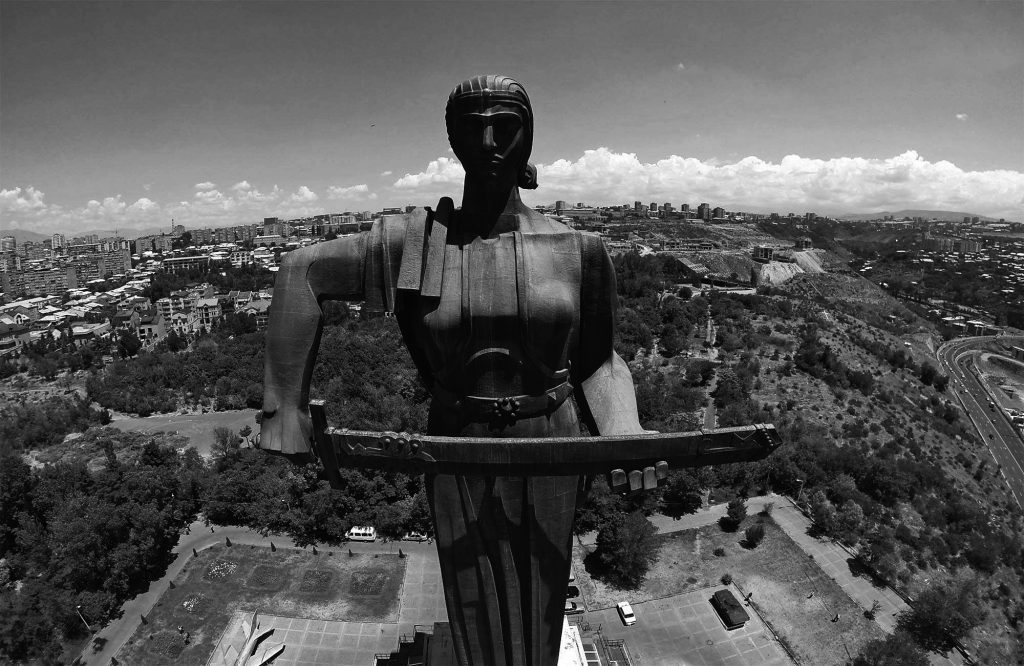Special to the Armenian Weekly
Mother Armenia is arguably the biggest statue in Yerevan and stands watchfully over the Turkish border. This nationalist symbol replaced the statue of the brutal dictator Joseph Stalin on the same basalt pedestal after his death. The statue seems the female personification of Armenia, portraying peace through strength. It might also remind viewers of the role of women in the long and bloody Armenian liberation movement more than a century ago that eventually led to the creation of the first Armenian Republic on May 28, 1918, after the centuries of statelessness since 1375.
The short-lived first Armenian Republic, which lasted just two years, was one of the first states to give women the right to vote—to elect and to be elected—even before women in the USA, who had to wait until 1920, when the Nineteenth Amendment was adopted.
Armenia today has 19 women in its National Assembly (Azgayin Zhoghov) consisting of 105 members. Several women served in the 80-person parliament of the first Republic, including three female members in 1919: Berjouhi Parseghian, Katarine Zalian-Manoukian, and Varvara Sahakian. The first Republic also boasted the first female consul (diplomat) in the modern world, Dr. Diana Apcar, who represented Armenia in Japan.
This article aims to highlight the importance of a pending bill, the Law on Preventing Domestic Violence in Armenia, as one of the first steps toward women’s empowerment, a theme central to Armenia’s development in the 21st century. The proposed law was drafted by Armenia’s Justice Ministry last year and recently submitted to parliament. It is expected to be voted on before the end of 2017.
The Armenian Revolutionary Federation (ARF) parliamentary bloc in Armenia, which consists of seven members of parliament (MPs), voiced support for the adoption of the bill, pending minor amendments. The ARF views the proposed bill as an essential part of a societal value system and necessary for a healthier society. Most recently, the ARF’s representative at the Socialist International Women (the international organization of the women’s organizations of the socialist, social democratic and labor parties affiliated to the Socialist International) affirmed its support for the elimination of violence against women everywhere, during its last council meeting in Barcelona.
The advocacy in this article is not an attempt at setting out either a modern Armenian feminist manifesto or engaging in “identity politics” in Armenian life. If Armenians are hoping to establish a fair society, then they need to be antipathetic toward injustice and sympathetic to mutual respect. Although the women’s agenda in Armenian political life in general remains rather undefined, fragmented, and sometimes ignored, the journey of Armenian female empowerment is an integral part of the Armenian political agenda. In this context, modern Armenian political thought needs to see gender inequality as a direct result of unequal power distribution. It also needs to engage by first focusing on ending violence against women and girls.
Three Considerations
First, and obviously, there is a problem in society and the existing regulatory framework in Armenia is insufficient to address it adequately. A specific law against domestic violence is necessary to complement existing provisions in the Family Code and Criminal Code of Armenia. Protecting human rights in this context is important not just when it is popular to do so but also, and even more importantly, when it might be unpopular.
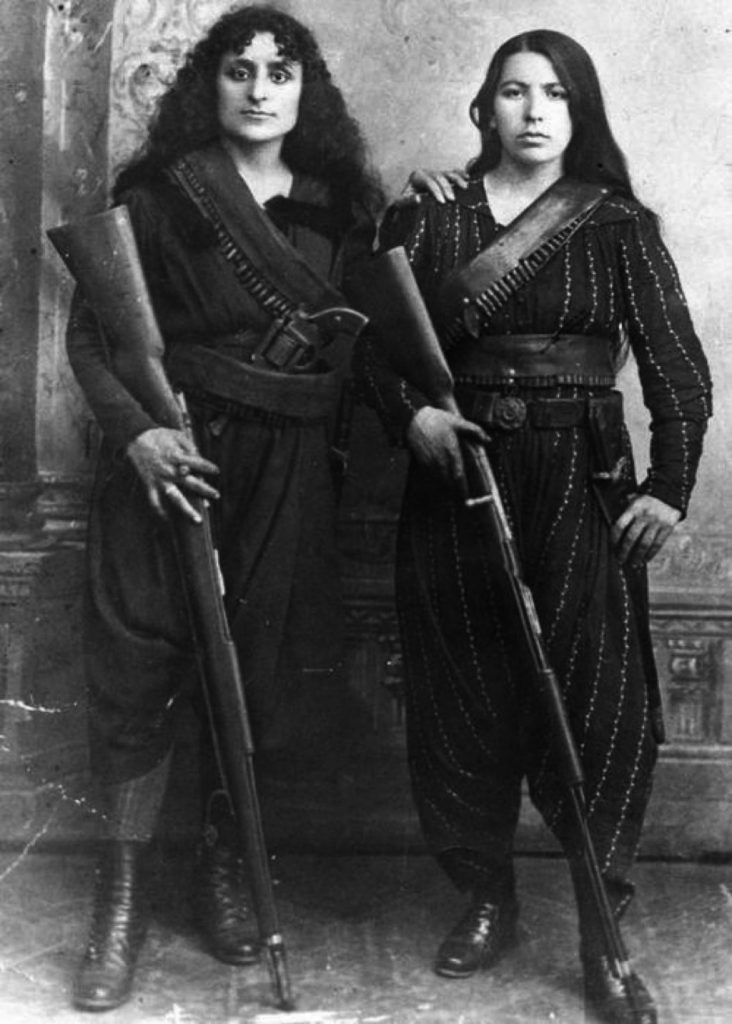
Armenian women took up arms in the the Armenian national liberation struggle of the late 19th and early 20th centuries. Photographed on the right is fedayi Eghisapet Sultanian. The other woman is unidentified. (Photo courtesy of Derek Sherinian)
Second, women’s rights should not be viewed from the lens of geopolitics (i.e., regional powers and the West) that sometimes wrongfully color these issues. Many in Armenia’s post-Soviet society still view attempts by women NGOs as agendas being funded by foreign powers from abroad.
Although considerable resource support from Western governments and nongovernmental donors has been channeled to NGOs helping at-risk women in Armenia, that does not constitute the entirety of the picture. An important consideration here is the European Neighborhood Policy and Enlargement Negotiations with Armenia. Commissioner for Enlargement and European Neighborhood Policy Johannes Hahn recently stated that the Armenia-EU agreement will be signed at an upcoming in Brussels in November (The signing occurred this past week. -Editor). The commissioner stressed that for the first time a country that is a member of the Eurasian Union will sign a far-reaching agreement with the European Union. He added that “it shows exactly that coexistence is possible and could serve as a blueprint for others.”
Although Armenia’s inclusive foreign policy is to be applauded, Armenian political thought needs to separate gender politics from geopolitics.
Over the last 10 years, there has been small but positive organic growth of the women’s movement in Armenia. However, as Armenia continues to struggle with its economic transition, few citizens have been able to channel funds to support NGOs that exist to empower women and help build institutions such as shelters for victims of domestic violence; only a handful of such shelters exist today.
Here, there is a role for the Armenian Diaspora as well. Organizations such as the Armenian Relief Society (ARS), which has issued a statement fully supporting the domestic violence bill, can do even more. It might, for example, re-examine its programs in Armenia and, in addition to its traditional kindergarten and orphanage projects, allocate funds to projects such as regional shelters necessary to support the new bill.
Armenian society cannot be transformed unless the place of women in it is transformed.
Third, according to the values expressed in the Constitution of the Republic of Armenia, and as set out in international treaties voluntarily signed by Armenia, a bill such as this one is entirely lawful.
Armenia is a signatory to the Convention on the Elimination of All Forms of Discrimination against women (CEDAW), an international treaty adopted by the UN General Assembly that acts as the “international bill of rights for women.” As part of the fifth and sixth periodic reports by UN committees on Armenia, suggestions were made to expedite the “adoption of a comprehensive law specifically criminalizing gender-based violence against women.”
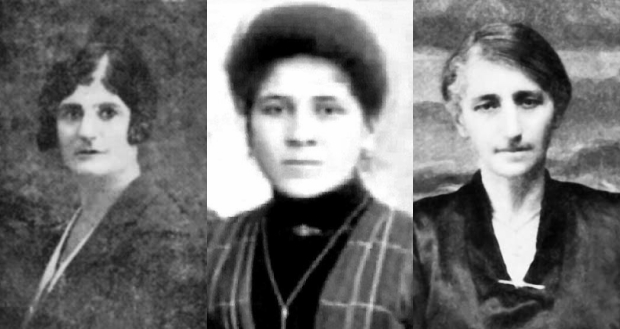
The three women parliamentarians—Berjouhi Parseghian, Katarine Zalian-Manoukian, and Varvara Sahakian—were elected to the first Armenian parliament in 1918.
Such a law is also coherent with the ARF’s views and longstanding values. As early 1909, and then during the First Republic, the ARF has officially promoted the equality of women and men, the right of women to vote and to be elected, and other rights related to women and children in the workplace.
Despite being in a coalition agreement with the ruling Republican Party of Armenia (RPA) at the moment, the ARF has differentiated itself many times in its history through its advocacy for progressive values. It seems to value Armenia’s commitments to the international community, as it has realized that most civilized societies have adopted mechanisms to address domestic violence (see the statement by the representative of the ARF Parliamentary bloc: “Our bloc will support the passage of this law, because we are a part of the world.”).

An excerpt from The Republic of Armenia: A Memorandum on the Recognition of the Government of the Republic of Armenia, Submitted by the Special Mission of the Republic of Armenia to the United States, published in Washington, D.C. in 1919, which explains that, “Every citizen of Armenia of full age has an equal right to participate in all elections without regard to sex, race, or religion.” The U.S. wouldn’t give women the right to vote until 1920.
In Armenia, domestic violence is a problem that remains on the margins of national discourse. A 2014 article in the Armenian Weekly discussed the seriousness of the problem, concluding, “The dedicated women and men confronting this horrible crime need help.” The introduction of the Law on Preventing Domestic Violence in Armenia is an opportunity for various constituents of Armenian society to participate in this process. This discourse should also include Armenia’s Diaspora.
The efforts of Armenia’s Justice Ministry, which drafted the law last year, should be welcomed by parties with longstanding values, such as the ARF. For the ARF, the law on domestic violence could be viewed, at its core, as a social justice issue. If domestic violence continues to receive inadequate attention in Armenia, then Armenian society is telling women (who make up the majority of Armenia’s population) that they have less worth than men and undermines them both as citizens and as human beings; that, in turn, undermines Armenian society as a whole.
Conclusions
Modern Armenian political thought needs to deconstruct the current conservative discourse on this issue in place since its post-Communist transition in 1991. Although the issue of gender inequality consists of many sub-issues in Armenian society, this author strongly believes the changing of attitudes needs to start somewhere. The law on preventing domestic violence in Armenia could represent an important milestone in that regard. No law is perfectly drafted from the very beginning, of course, but that should not be a reason to reject it.
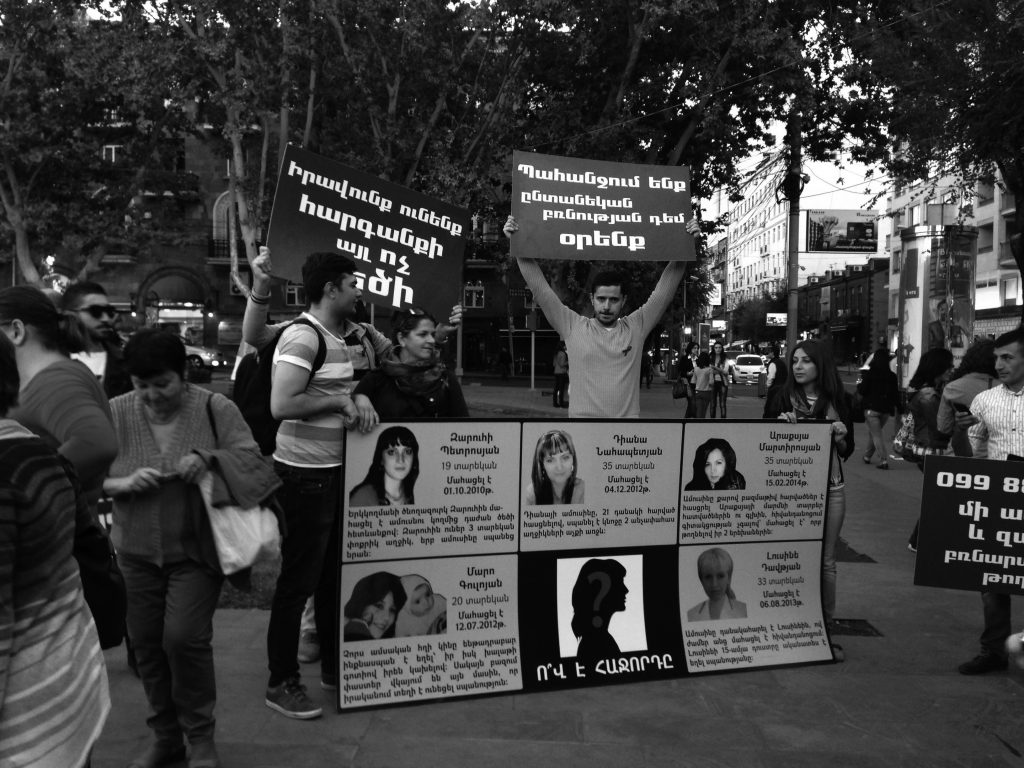
A scene from a 2014 Yerevan protest against domestic violence. The large banner displays the photographs of women in Armenia killed as a result of domestic violence (Photo: Michael Mensoian/The Armenian Weekly)
The narrow post-Soviet version of Armenian state nationalism has not been an able substitute for a national ideology, nor has it been a true reflection of Armenian traditional values. Gender equality should be valued in the context of equal opportunities. The international community has recognized the importance of supporting gender equality through CEDAW, the Millennium Development Goals, and other treaties and commitments to which Armenia is a signatory.
As the centennial of Armenia’s statehood approaches, modern Armenian political thought needs to address deeper issues, beyond this imminent bill, such as why Armenia has the third highest rate of abortion of female fetuses in the world, behind only China and Azerbaijan. Is the pension system for Armenia properly providing for women? Why is unemployment higher among women in Armenia? How can Armenian women’s NGOs connect better with their constituency and potentially empower them to self-govern in rural regions, where men are absent in large numbers, having gone abroad for work?
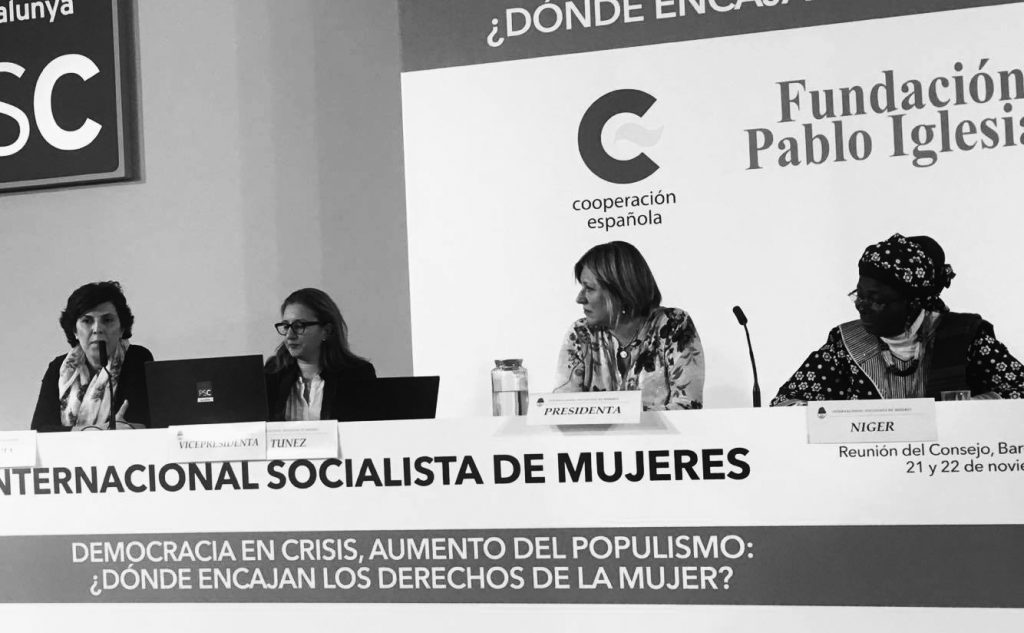
Recently, the ARF’s representative at the Socialist International Women (far left), affirmed its support for the elimination of violence against women everywhere, during its last council meeting in Barcelona (Photo: SI Women)
Armenian political thought at the dawn of 2018 needs to think big, and to see what better participation of women can do to Armenian society.
Women, who make up over 55% of Armenia’s population, have been overlooked as a vital talent source. Armenian women have worked next to men in the past, and such labor did not seem hierarchical, per se, as men and women tended to work in the home and surrounding farms in the pre-industrial era. Armenian women worked to produce clothing, soap, candles, and other necessities in the home economy. When manufacturing moved out of the homes and into the factories after the industrial revolution, Armenian women, during the Soviet era, had equal rights in both work and education, along with privileges (e.g., prenatal and postnatal vacation, and legal rights to abortion since 1920). Women in Soviet Armenia were not too “feminine” to work in factories, to be successful engineers, or to participate in the Second World War.
The socioeconomic situation of Armenia’s women changed drastically after 1991 as Armenia’s economy plummeted along with the Soviet Union, and jobs became scarce in Armenia and poverty levels rose. In many ways, President Levon Ter-Petrosyan’s hasty, nonorderly (and ultimately disastrous) privatization efforts deepened Armenia’s de-industrialization. As a consequence of Armenia’s post-Soviet crony neo-capitalism, many women continued losing jobs, which contributed to the de facto inferior status of women in Armenian society today.
Furthermore, there seem to be various obstacles preventing women’s political participation in Armenian life today. These include gender stereotypes, gender roles, women’s lack of economic independence and social capital, along with the prevailing political culture in the country. Armenian woman’s role in society seems to have shrunk under the impact of bad governance, the reign of the oligarchs, and hollow state nationalism of the past 25 years.
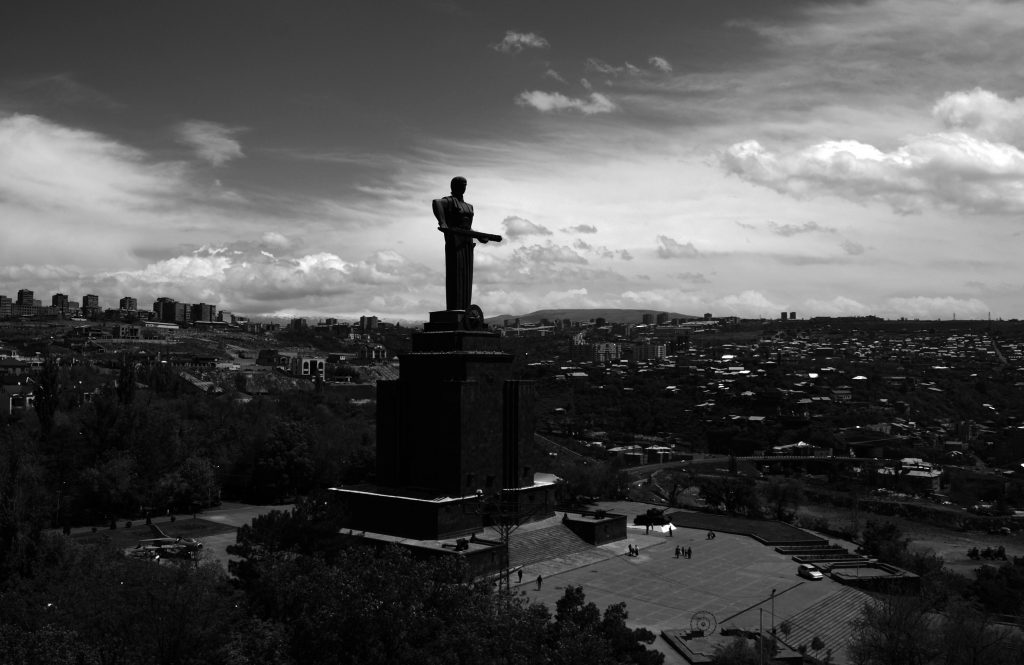
“Armenian political thought at the dawn of 2018 needs to think big, and to see what better participation of women can do to Armenian society” (Photo: Armine Aghayan)
The Armenian nation is a collective project that is worthwhile. And it involves all members of society. We need to act now to tap into the opportunity to capitalize on the significant and proven difference that women can make in Armenia. We cannot make excuses or retreat. We cannot just proclaim equality and expect the problem solved. We must create the necessary environment where equality can thrive.
Revitalizing the women’s agenda in Armenia could be one of the best tributes to our founding female parliamentarians and our homage to the first republic in general. 2018 is not merely the year for Armenians to be proud of their statehood; in 2018, Armenians will also be celebrating 100 years of voting rights for women in Armenia. The law on domestic violence is a moment for a serious, and engaging national conversation among Armenians of all classes and backgrounds. It can also be a catalyst to start addressing cultural and social norms that are no longer helping Armenian society.
***
This is the second article in a series dedicated to the upcoming 100th anniversary of Armenian statehood and Armenian political thought. The first article, entitled “Beyond Nationalism: The Case for Engaged Patriotism on the Eve of the 100th Anniversary of Statehood,” by Varak Ketsemanian and Raffy Ardhaldjian, can be read here.
The post A Century after the Progressive First Republic, It’s Time to Criminalize Domestic Violence in Armenia appeared first on The Armenian Weekly.
Source: Armenian Weekly
Link: A Century after the Progressive First Republic, It’s Time to Criminalize Domestic Violence in Armenia

